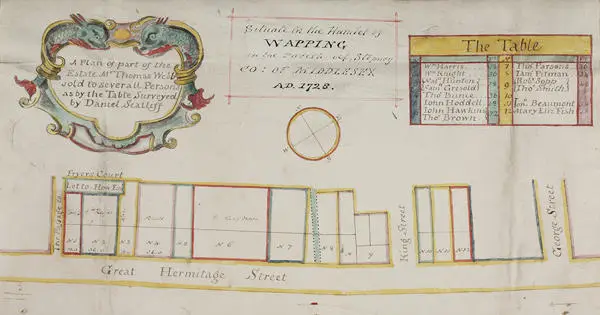Manors, property and family estates
The records of ancient manors and grand estates are a rich source of information for social, economic, local and family history. Through documents such as court rolls, field surveys and lists of tenants a researcher can reveal the complexity of a community; identifying officials, witnessing minor crimes, tracing land use and learning who held economic power. They also track urban development, as quiet medieval hamlets miles away from the small town of London became suburbs of the vast city.
Estate records are found in the collections of families and land-owning organisations such as the Church, charities or livery companies. Records include manorial court rolls; estate management records such as rentals, lists of tenants, surveys, valuations, inventories, financial accounts, maps and plans; property transactions such as title deeds; legal documents; records relating to local parishes and tithes; and papers of land enclosure. Collections relating to a manorial family often include papers of the family themselves, including correspondence, marriage settlements, wills and bequests, personal finances, diaries, pedigree books, genealogies, and records relating to the family business.
For example, the papers of the Wood family (spanning 1542-1815, reference ACC/0262) provide a fascinating picture of the concerns of a seventeenth century businessman and his family. Merchant Edward Wood (1604-1667) lived in the City of London until 1663 when he purchased an estate in Littleton, Middlesex. As well as records of the estate, the collection includes a long series of letters from Wood to his agent in London, in which he puts in orders for building materials and workmen, makes arrangements for his tomb monument, and gives instructions to escape the city during the outbreak of Plague in 1665. Family letters illuminate domestic arrangements, education, the difficulties of choosing a marriage partner and medical ailments.

The collection of the Russell family, Dukes of Bedford (spanning 1552-1922, reference E/BER) relates to the development of part of their estate, an orchard of Westminster Abbey acquired from the Crown by John Russell, first Earl of Bedford in 1552, and developed between 1630 and 1641 by Francis Russell, fourth Earl. Inigo Jones appears to have been largely responsible for planning the lay-out, the central feature of which was an Italian-style 'piazza', the first London square, which later became Covent Garden Market. Many of the records relate to the development of the Market, which was leased by the Bedford Estate during the late 17th and 18th centuries, but actually administered by the Estate during the 19th and early 20th centuries. Other records concern Drury Lane Theatre and the Covent Garden Theatre (now the Royal Opera House).
The Irish Society owes its existence to James I's policy of settling or 'planting' Ulster with English and Scottish Protestants, a policy which the Corporation of the City of London and the London Livery Companies were somewhat reluctantly compelled to administer. The collection (spanning 1613 – 1983, reference CLA/049) includes papers relating to the management of estates in Londonderry and Coleraine, notably the Great Parchment Book of 1639 which contains copies of contracts for leases of estates within the Ulster Plantation including the proportions held by the great twelve livery companies, freehold lands and native lands.